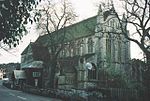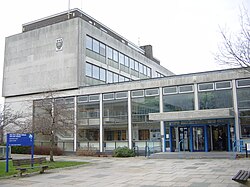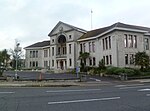Parkstone railway station

Parkstone railway station serves the Parkstone area of Poole in Dorset, England. The platform sign formerly read Parkstone (for Sandbanks). The station is operated by South Western Railway and is served by both the Weymouth express and the Poole stopping services. It is sited 111 miles 76 chains (180.2 km) down the line from London Waterloo. The station is able to accommodate trains of up to five coaches; longer trains only open the doors in the first four or five coaches, depending on the type of unit operating the service. It was served by the Somerset and Dorset Joint Railway line from Bath Green Park to Bournemouth West from 1874 until 1966, when it was closed under the Beeching Axe. Until 1967, a branch goods line ran from here to the George Jennings South Western Pottery. The line extended from the Pottery to Salterns Pier, on the northern shores of Poole Harbour, until 1922. The line between Bournemouth and Weymouth was electrified in 1988, using the standard British Rail Southern Region system of a third rail with 750 volts direct current.
Excerpt from the Wikipedia article Parkstone railway station (License: CC BY-SA 3.0, Authors, Images).Parkstone railway station
Station Road,
Geographical coordinates (GPS) Address Nearby Places Show on map
Geographical coordinates (GPS)
| Latitude | Longitude |
|---|---|
| N 50.723 ° | E -1.949 ° |
Address
Station Road
Station Road
BH14 8UG , Parkstone
England, United Kingdom
Open on Google Maps









